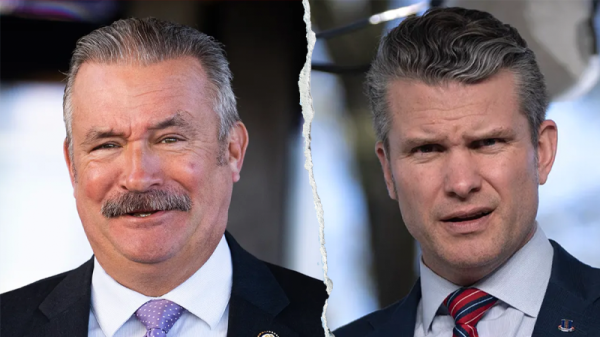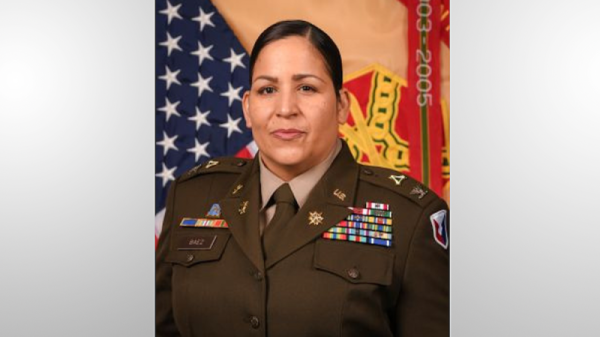When Tim Sheehy completed training as a Navy SEAL in 2009 and shipped off to Iraq, the elite fighting force was not a household name. People in airports were perplexed when he told them what he did, he would later say.
That all changed in 2011, when a SEAL team conducted the raid that killed Osama bin Laden, a shift that took Sheehy, now the Republican candidate for U.S. Senate in Montana, by surprise. Suddenly, he said, “SEALs were everywhere, you know — TV shows, books.”
“It was crazy,” Sheehy, 38, added in a podcast interview last November. “And to be honest, we got overexposed.” As a result, he said, “Sometimes I hate saying I was a Navy SEAL because I was like, ‘Oh great, I’m so sick of hearing about Navy SEALs.’”
But as he campaigns in one of the country’s most competitive Senate races, which could decide control of the chamber, Sheehy — a decorated veteran who earned a Purple Heart and Bronze Star — is hardly circumspect about his work as a Navy SEAL.
He lists it as the first line in all his online profiles. He splashed it across his campaign website. He mentioned it nearly 70 times in his 2023 memoir. He told the audience at a Republican women’s meeting in Montana last fall, “I’m a war hero, a job creator, a philanthropist.”
In touting his time as a SEAL, however, Sheehy has sometimes contradicted himself and made puzzling statements about aspects of his Navy activity.
Most notably, Sheehy, who now owns an aerial firefighting business, has told voters that he has a bullet in his arm from combat in Afghanistan. But he told a National Park Service ranger in 2015 that he had accidentally shot himself when his Colt .45 revolver fell and discharged in Montana’s Glacier National Park, according to a record of the episode filed in court. When asked about that account last week, Sheehy told The Washington Post that he had lied to the ranger to protect himself and his former platoonmates from scrutiny over an old bullet wound that he said he had suffered in Afghanistan in 2012.
This week, after The Post sent new questions to Sheehy’s campaign, the candidate posted part of the inquiry on social media and warned of a “hit piece attacking me for serving my country.” Katie Martin, a campaign spokeswoman, did not respond to those questions but issued a statement saying, in part, “Tim Sheehy humbly served our nation with honor as a Navy SEAL. He has never called himself a hero, but he served alongside plenty of them. His military service is well documented and is a matter of public record.”
Since The Post first reported Sheehy’s 2015 encounter with the park ranger, some Republicans in Montana and nationally have rallied around him. VoteVets, the liberal political action committee focused on electing veterans, said it was “deeply troubled that a fellow veteran may have misrepresented aspects of their service while trying to win a political campaign” and called on Sheehy to release underlying medical records.
In discussing his Navy career, Sheehy has highlighted the work he did with the unit that killed Bin Laden, SEAL Team Six, also sometimes called “Task Force Blue,” tying himself in the process to one of its darkest episodes, the death of an aid worker in a failed rescue attempt.
Finally, Sheehy has offered different explanations for his exit from the Navy — variously saying he left because of wounds from Afghanistan and because of a heart problem triggered by an underwater training mission in the Pacific.
All political candidates must promote their work experience. The blend of secrecy and valor central to SEAL activity makes that task more promising — but also more perilous. Part of the official SEAL ethos states, “I do not advertise the nature of my work, nor seek recognition for my actions.”
Still, Sheehy joins a growing number of former SEALs discussing that work as they work to win votes. In the decade since Rep. Ryan Zinke (R-Mont.) became the first former Navy SEAL elected to Congress in 2014, the ranks of retired members of the elite force have swelled to five — all Republican, from Texas, Arizona and Wisconsin, in addition to Montana.
Sheehy would be the sixth, and the second from Montana after Zinke. His path points to the dilemmas involved in mixing politics with the SEAL ethos.
“There’s this conflict inside the SEAL teams between being the quiet professional, which is the professed ideal, and trading on the reputation of the organization for your own personal benefit,” said Dave Madden, a former Navy SEAL who served with Sheehy in Afghanistan and declined to comment specifically on his former platoonmate.
Sheehy grew up outside Minneapolis. His father was in the financial services industry, and his mother has worked as a museum docent, according to a college roommate, Nick Adkins.
The Sept. 11 attacks were decisive for him, Sheehy wrote in his 2023 memoir, “Mudslingers.”
“Like a lot of young men in the early 2000s, I was eager to fight,” he wrote. “Who needed college when the world seemingly was on fire?”
His parents insisted on college, he wrote, so he applied and gained admission to the U.S. Naval Academy.
Adkins, his roommate for all four years, said Sheehy was driven and exacting. He took issue with the film “300,” Adkins said, because he said it included inaccuracies about the Battle of Thermopylae in the Greco-Persian Wars. He was first impressed by the woman who would become his wife, Carmen, a Naval Academy classmate who would go on to became a Marine, because she could do more pull-ups than he could, according to Adkins.
While at the Naval Academy, Sheehy also went to Ranger School in 2006, the Army’s rigorous tactical leadership course, part of what he described as an “experimental program” to integrate Navy officers in Army operations at a time when Special Operations units were under pressure globally.
Another classmate, Donnie Horner III, said Sheehy “doesn’t view being a Ranger, being a SEAL or even being a U.S. Senate candidate at 38 as something to brag about or a feather in his cap. He sees it as his commitment to duty and service.”
Reflecting on Sheehy’s current task of translating that experience to the campaign trail, Horner said: “I would say it would not come naturally for him to talk about his extraordinary career as a Ranger or a SEAL.”
Sheehy completed SEAL training in 2009 and quickly deployed to Iraq.
“I went right to a team that was already deployed,” Sheehy said in the November 2023 interview, explaining to a county sheriff and podcast host in Montana how he graduated, drove across the country, “hopped on a plane, and was in Iraq a day later.”
Sheehy was eager to see combat, as he wrote in his memoir, but he spent much of his first deployment in an operations center in Baghdad, according to Matt Stevens, the commanding officer of the SEAL team that welcomed the young recruit.
Because Sheehy joined midway through the deployment, Stevens said, he focused mainly on behind-the-scenes work in the Iraqi capital.
He did that work well, according to Stevens. “He was more mature than his peers,” said the former commanding officer, “being a guy who could get things done, anticipate and take the initiative.”
Sheehy has said he completed several additional deployments in the Middle East and Central Asia, while also conducting counternarcotics work in South America — “deep in the Amazon” — and taking part in a “special reconnaissance team that would do missions around the world.”
In the fall of 2010, Sheehy assisted in the failed effort to rescue Linda Norgrove, a British aid worker whom the Taliban had kidnapped in eastern Afghanistan, according to Sheehy’s memoir. The effort, botched when a grenade thrown by a U.S. service member killed Norgrove, was led by the same elite SEAL team that would later kill bin Laden, according to published accounts.
Sheehy wrote that he was assigned to a classified task force and served “as a liaison between ‘Blue’ and our Army counterparts.” He recalled that “the process was maddening and the final result dispiriting.”
At an event promoting his memoir earlier this year, he called the Norgrove assignment “one of the most daring hostage rescue missions ever.” And he boasted of his responsibilities as a 25-year-old SEAL: “I’m up there running … you know, a task force to find a hostage.”
Sheehy’s unit had difficulties of its own in Afghanistan.
He was the officer in charge of a small platoon that spent the first half of 2012 deployed mostly in southeast Afghanistan, according to multiple former members of the platoon, some of whom spoke on the condition of anonymity because they were still on active duty or in other fields that do not allow them to discuss past work.
Unlike most of his time in Baghdad, this was a very hazardous deployment for Sheehy — “firefights, IEDs almost daily,” recalled Scott Weaver, a platoonmate who was responsible for clearing explosive devices. The platoon was conducting what are called “village stability operations” — living in small rural outposts and seeking to empower local Afghans to take back control from the Taliban.
April 2012 was an especially brutal month for the platoon. That’s when Sheehy suffered the injuries that earned him a Purple Heart, which came after he was knocked unconscious by an IED blast, according to a local news report about his ceremony.
It was also the month that two members of the platoon were medically evacuated after being wounded in explosive blasts — first Craig Meekins, whom Sheehy carried on his shoulder to a helicopter, in an act that would later earn him a Bronze Star, and then Weaver, who said his left calf was blown off when a truck detonated an explosive device.
Weaver recalled in a podcast interview last summer how he had posed for a photo on a stretcher before being evacuated — part of a tradition of documenting combat wounds.
“The guys in war that had been hit had this kind of sick thing where whenever you got hit or shot, you had to do a picture with your thumbs up,” he said in the interview. “It was like the cool guy picture, right?”
But soon after, Sheehy broke with tradition and kept a gunshot wound private, according to the account he gave to The Post last week.
He said he suffered the wound at issue in the park ranger’s report in late April or May of 2012. He said he was unsure if the ricochet bullet that landed in his arm had come from enemy combatants or friendly fire, though he believed two members of his unit were positioned such that they may have been responsible. In his memoir, by contrast, he wrote that he knew which member of his team — a “total stud” — had accidentally shot him, and kept it quiet to protect that person and to avoid being sent away for medical treatment.
Sheehy said he received no treatment for the wound and feared disclosing it to the park ranger in Montana, three years later, because he was still a reservist at that time and thought such a disclosure could spark a Navy investigation — a possibility that some military experts said was remote. Sheehy said he didn’t shoot himself in the park but rather fell and cut his arm, an injury that he worried might have dislodged the bullet. He said he decided to go to the emergency room, where he said he informed hospital staff of the bullet in his arm, and hospital officials said they had to alert law enforcement of all gunshot wounds, leading to the interaction with the park ranger.
Sheehy’s campaign arranged an interview with a former member of the platoon who said he remembered Sheehy telling him while they were both in Afghanistan that he had been hit by a ricochet bullet but that he didn’t want to report the wound. The former platoon member spoke on the condition of anonymity because he is a military reservist and said he is not authorized to speak to the media.
The Post interviewed several other former members of the platoon who served with Sheehy during his 2012 deployment and said they understood why Sheehy might have kept a gunshot wound to himself — but said the only wounds they knew Sheehy to have suffered involved traumatic brain injury from explosive blasts. These former platoonmates said he didn’t mention a gunshot wound during the deployment or when platoon members reconvened in Virginia Beach later in 2012.
Weaver chalked up such a move up to his leadership qualities.
“His mindset was, ‘always the first one in, always the last one out,’ even when that put him in danger,” Weaver said. “At first I thought he had a death wish, but I very soon came to realize that’s just his leadership style.”
He probably feared “being shipped home away from his team,” Weaver added.
After that deployment, Sheehy moved to Honolulu, where he oversaw undersea missions until the fall of 2014, according to a résumé he submitted to the Montana legislature. That résumé, dated January 2021, says he was ultimately “medically separated from active duty due to wounds received in Afghanistan.”
Elsewhere, Sheehy has offered a different account of his departure from the Navy. In his 2023 memoir, he wrote that he decided to leave the Navy after a submarine incident in the Pacific left him with decompression sickness that made him “damaged goods” and would keep him from active duty. In the November 2023 podcast interview, he said the incident “popped a hole in my heart.”
Martin, the Sheehy spokeswoman, did not address the discrepancy, saying only, “Sheehy was honorably discharged from the Navy after being declared medically unfit to continue to serve as a Navy SEAL.”
As he looked for a place to land, he wrote in his memoir, “Montana seemed like the ideal spot.” It wasn’t too far from his home in Minnesota and offered plenty of outdoor space. He soon bought the aircraft — a 40-year-old Twin Commander 500 — that would become the centerpiece of his aerial firefighting business.
In 2015, he was awarded the Bronze Star and Purple Heart in a ceremony presided over by Zinke, also a former Navy SEAL and then a Republican congressman from Montana who would later become Donald Trump’s interior secretary. Zinke returned to the U.S. House in 2023, the same year Sheehy launched his Senate campaign.
His launch video opens with footage from the Sept. 11 attacks and uses font reminiscent of military movies and video games.
Other ads are peppered with photos of Sheehy in military fatigues. In one, he ties his war experience to the culture wars, telling the camera, “I’m a combat-wounded Navy SEAL running for the Senate to get this woke crap out of our military and to keep our country safe.”
Alice Crites, Alex Horton, Fenit Nirappil, and Aaron Schaffer contributed to this report.


































